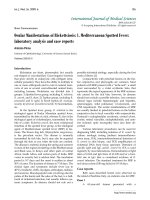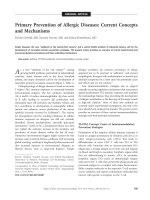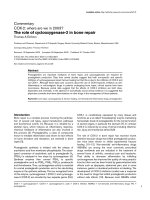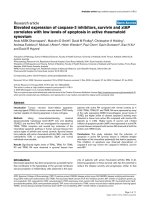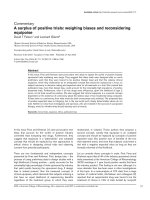Báo cáo y học: "Ocular manifestations of Rickettsiosis: 2. Retinal involvement and treatment" docx
Bạn đang xem bản rút gọn của tài liệu. Xem và tải ngay bản đầy đủ của tài liệu tại đây (112.74 KB, 1 trang )
Int. J. Med. Sci. 2009, 6
128
I
I
n
n
t
t
e
e
r
r
n
n
a
a
t
t
i
i
o
o
n
n
a
a
l
l
J
J
o
o
u
u
r
r
n
n
a
a
l
l
o
o
f
f
M
M
e
e
d
d
i
i
c
c
a
a
l
l
S
S
c
c
i
i
e
e
n
n
c
c
e
e
s
s
2009; 6(3):128
© Ivyspring International Publisher. All rights reserved
Short Communication
Ocular manifestations of Rickettsiosis: 2. Retinal involvement and treat-
ment
Leila El Matri
Department of Ophthalmology - Heidi Raies Eye Institute,Tunis (Tunisia)
Published: 2009.03.19
The presence of retinitis, retinal vasculitis, optic
neuropathy, or any intraocular inflammatory condi-
tion in a patient with fever or rash, living in or re-
turning from from an endemic area, especially during
spring or summer, strongly suggests a diagnosis of
Rickettsiosis.
Systemic fundus examination, complemented
with fluorescein angiography and ICG angiography
in selected cases, may help establish the diagnosis of
rickettsiosis while serologic testing is pending. Pre-
vention is the mainstay of the disease control i.e.
personal prevention against tick bites in endemic ar-
eas and improvement of sanitary conditions.
In patients with rickettsiosis retinal vascular in-
volvement may present different clinical pictures:
branch retinal artery occlusion, cystoid macular oe-
dema, serous retinal detachment, and hypofluores-
cent choroidal spots.
[1] Rickettsial retinitis presents
as white retinal lesions that are typically juxtavascular
in location and are associated with mild vitreitis. Dif-
ferential diagnosis with Toxoplasmosis is often re-
quired. Large foci tend to involve all retinal layers
extending to the retinal pigment epithelium and more
deeply until the choroid. Small foci may also involve
the entire retinal thickness, but in some cases only
superficial retinal layers are involved and lesions re-
semble cotton-wool spots. White retinal lesions may
number from 1 to more than 5, may be variable in size
and located at the periphery or posteriorly. If the optic
disk is involved, there may be disc oedema and
staining.
[2]
Treatment
Systemic antibiotic treatment with doxycycline
(100 mg/day for 10-14 days) represents the basic
treatment. Systemic steroids, in association with do-
cycycline is mandatory in the case of severe retinitis
extending to the macular region, vitriitis, retinal vas-
cular occlusion or optic nerve involvement. Further-
more, the ophthalmologist should also choose to add
local therapy, depending on the main ocular symptom
i.e. topical antibiotics for conjunctivits or keratitis,
topical steroids and mydriatics if anterior uveitis is
present.
References
1. Moncef Khairallah, Ahmed Ladjimi, Mohamed Chakroun, Riad
Messaoud, Salim Ben Yahia, Sonia Zaouali, Foued Ben
Romdhane, Noureddine Bouzouaia. Posterior segment mani-
festations of Rickettsia conorii infection. Ophthalmology 2004;
111:529-534
2. Moncef Khairallah, Sonia Zaouali, Salim Ben Yahia, Ahmed
Ladjimi, Riadl Messaoud and Sonia Attia. Anterior Ischemic
Optic Neuropathy Associated with Rickettsia Conorii Infection.
J Neuro-Ophthalmol 2005; 25:3


